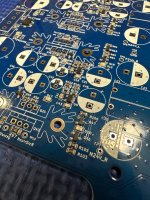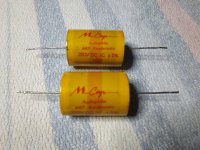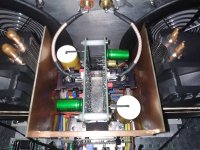The few SMD components in the AN project should not be driving force to abort the mission. There are other aspects to successfully building an amplifier that should concern you more than a couple surface mount parts.
Like any project proper tools go a long way in accomplishing your goal. A quality solder iron with easy to swap tips is a good starting point (Weller & Hackko are good examples), eye magnification headgear is a must, look on Amazon. No hot air station is needed here, just a fine tip, flux and eye magnification.
With all the good through hole transistors going EOL, surface mount soldering is going to be the only choice if you want to stay in this hobby. Sounds like you're not afraid to give smd soldering a go, great! The only way to get better is to dive in.
Best of Luck!
Like any project proper tools go a long way in accomplishing your goal. A quality solder iron with easy to swap tips is a good starting point (Weller & Hackko are good examples), eye magnification headgear is a must, look on Amazon. No hot air station is needed here, just a fine tip, flux and eye magnification.
With all the good through hole transistors going EOL, surface mount soldering is going to be the only choice if you want to stay in this hobby. Sounds like you're not afraid to give smd soldering a go, great! The only way to get better is to dive in.
Best of Luck!
AD24QS put out by Uwe Beis (a kit).
Thanks, Andy.
Tho … Bummer… in 2022 it became “sold out, Successor planned” but still not available
Any other suggestion/s?
I ain't skerd 😉 thanks for the advice!The few SMD components in the AN project should not be driving force to abort the mission. There are other aspects to successfully building an amplifier that should concern you more than a couple surface mount parts.
Like any project proper tools go a long way in accomplishing your goal. A quality solder iron with easy to swap tips is a good starting point (Weller & Hackko are good examples), eye magnification headgear is a must, look on Amazon. No hot air station is needed here, just a fine tip, flux and eye magnification.
With all the good through hole transistors going EOL, surface mount soldering is going to be the only choice if you want to stay in this hobby. Sounds like you're not afraid to give smd soldering a go, great! The only way to get better is to dive in.
Best of Luck!
Right on!
Be careful though..... after successfully building your first Class A many more will follow! Hope you have room for storage .
.
Be careful though..... after successfully building your first Class A many more will follow! Hope you have room for storage
 .
.Either the AN or Aleph JZM would sound superb. If you haven’t previously built an amp? the AJZM would “surely” be a more sensible option.
Tho maybe a bigger challenge is one of your criteria?
You could always do the AN as the next project.
Tho maybe a bigger challenge is one of your criteria?
You could always do the AN as the next project.
should not be driving force to abort the mission
several bits of very good advice in your post.
Though at the risk of stating an obvious: deciding to not build an AN isn’t mission aborted, it’s alternative mission commenced
The AN is more clever with its efficiency.
Though the no 1 criteria - SQ. From anyone who has compared the AN to any of the Pass amps, what did you think?
Though the no 1 criteria - SQ. From anyone who has compared the AN to any of the Pass amps, what did you think?
I 'll be keen to know about that.The AN is more clever with its efficiency.
Though the no 1 criteria - SQ. From anyone who has compared the AN to any of the Pass amps, what did you think?
When you say fine tip... I have a Hackko iron, what size do you suggest for the tip?The few SMD components in the AN project should not be driving force to abort the mission. There are other aspects to successfully building an amplifier that should concern you more than a couple surface mount parts.
Like any project proper tools go a long way in accomplishing your goal. A quality solder iron with easy to swap tips is a good starting point (Weller & Hackko are good examples), eye magnification headgear is a must, look on Amazon. No hot air station is needed here, just a fine tip, flux and eye magnification.
With all the good through hole transistors going EOL, surface mount soldering is going to be the only choice if you want to stay in this hobby. Sounds like you're not afraid to give smd soldering a go, great! The only way to get better is to dive in.
Best of Luck!
SMD need not be so hard. Just a fine clean tip, tweezers and a magnifier is all you need. Dot one pad with a modest blob of solder. Get the component on the board, place it on the opposite side of the footprint to the pad you blobbed. I use my right hand to gently hold the component in the tweezers whilst melting the blobbed pad with the left. Slide the component into the molten solder and check the placement before you remove the iron. Solder the other pad and that's it. A 1206 is easy, I can do SOICs and 0603s with not too much of problem. Some solder wick is handy if you get enthusiastic with the solder.
I 'll be keen to know about that.
It was written up in the early development of the Nirvana. ie a few years ago in the early pages of this thread. I’m not great at explaining it but searching this thread would get you the words of the designer. The relatively high efficiency for Class A amplification was the work of Hugh Dean
Listening impressions and comparing to some Pass amps by Voiceofposeidon here:The AN is more clever with its efficiency.
Though the no 1 criteria - SQ. From anyone who has compared the AN to any of the Pass amps, what did you think?
Hi BAS!
I have built both. The Alpha Nirvana is definitely better in all parameters (neutrality, staging, imaging precision, and particularly microdetails). The Alpha 20 was an improvement over the Nelson Pass Aleph J and closer to Zen Mod’s Aleph J Zen. I would put the Alpha 20 and Aleph J Zen on practically the same plane as far as sonic impressions go. But the Alpha Nirvana is another level above those 3 designs as the current source design is different - it isn’t an Aleph based current source. It also puts out more power, which is impressive as all 4 designs are Single Ended Class A...
I have built both. The Alpha Nirvana is definitely better in all parameters (neutrality, staging, imaging precision, and particularly microdetails). The Alpha 20 was an improvement over the Nelson Pass Aleph J and closer to Zen Mod’s Aleph J Zen. I would put the Alpha 20 and Aleph J Zen on practically the same plane as far as sonic impressions go. But the Alpha Nirvana is another level above those 3 designs as the current source design is different - it isn’t an Aleph based current source. It also puts out more power, which is impressive as all 4 designs are Single Ended Class A...
Merry Christmas to all of you.
I wish you all the best and to all of you and your families.
The last change I made to my Nirvana amp was to replace the input capacitor from which it was Έlna silmic electrolytic In a simple M cap 10uf/250V The difference was very noticeable for the better. I would also like to proceed with reducing the feedback gain 22k/820 to 22k/2.2k or 1.8.k since I have version 4R I would like the opinions on this from those of you who have done it.
It is truly a very detailed and colorful amplifier, very pleasantly surprised.
I wish you all the best and to all of you and your families.
The last change I made to my Nirvana amp was to replace the input capacitor from which it was Έlna silmic electrolytic In a simple M cap 10uf/250V The difference was very noticeable for the better. I would also like to proceed with reducing the feedback gain 22k/820 to 22k/2.2k or 1.8.k since I have version 4R I would like the opinions on this from those of you who have done it.
It is truly a very detailed and colorful amplifier, very pleasantly surprised.
Attachments
Last edited:
Same to you Nikos, good parties!!!
Varying R124 from 820R changes the harmonic
distortion of the AN. I wouldn't move too much from 22k/1.8k - 2k2. Increasing R124 gradually fades the profile that the designer Mr. Hugh Dean has achieved, you know, monotonically decreasing.
Fellow Danny shared with me some fantastic information on this... thanks a lot Danny!!!
820R

1.8K

3.9k

10K

I was going high as 10K and I'm going back to 820R (1.8K I think would also be fine). I'm going to try lowering the gain through a resistive divider filter on the AN input.
Regards
Varying R124 from 820R changes the harmonic
distortion of the AN. I wouldn't move too much from 22k/1.8k - 2k2. Increasing R124 gradually fades the profile that the designer Mr. Hugh Dean has achieved, you know, monotonically decreasing.
Fellow Danny shared with me some fantastic information on this... thanks a lot Danny!!!
820R
1.8K
3.9k
10K
I was going high as 10K and I'm going back to 820R (1.8K I think would also be fine). I'm going to try lowering the gain through a resistive divider filter on the AN input.
Regards
Hi Nikos,Merry Christmas to all of you.
I wish you all the best and to all of you and your families.
The last change I made to my Nirvana amp was to replace the input capacitor from which it was Έlna silmic electrolytic In a simple M cap 10uf/250V The difference was very noticeable for the better. I would also like to proceed with reducing the feedback gain 22k/820 to 22k/2.2k or 1.8.k since I have version 4R I would like the opinions on this from those of you who have done it.
It is truly a very detailed and colorful amplifier, very pleasantly surprised.
Merry Christmas to you and everyone else on this thread! Hopefully you are all enjoying your AN over the holidays.
Your arrangement is very cool (literally). 😃
The use of CPU coolers is a great way to save weight and expense of heavy heatsinks. Plus, it keeps the amp much cooler running. Your arrangement of the two amp boards back to back and having the two input RCA’s close to each other is an excellent way to minimize the potential for ground loop and EMI pickup since the loop area is very small. Nice work!
Thank you X! Likewise for you and for all the participants of this thread, which in one way or another have been flattening the road for those of us who came behind!!!
Cheers and good luck 👍
Cheers and good luck 👍
Thank you very much.Nice work!
Thanks to you for showing us this type of cooling in a more professional way..
You have my undivided gratitude.
Finally, a new reference has stood up 🙂
Yesterday, my friend Bernard and I had a listening session and the Alpha Nirvana came out as best.
The last 5 years it was always his FirstWatt Sony vFet PP amplifier that was victorious,
but now the Alpha Nirvana gave a better overall sound, especially the soundstage depth stood out.
And this with the Alpha Nirvana that I just finished assembling a few hours before.
Some more info about the build:
The case and the power supply were from a previous build ALPHA amplifier (the predecessor of the Alpha Nirvana).
The power supply is a dual mono with Toriody transfos, LT4320 bridges and CLC.
For the Alpha Nirvana I used bulk foil resistors for the critical positions and Isabellenhutte PBH as source resistors, other resistors are cmf60/rn60
Input caps are Clarity cap PUR, the rest Muse ES, Elna Simic and Jupiter Cosmos wet capacitors.
As feedback resistor I used 1.8K instead of 825r, this lowers the gain and when using 4 ohm speakers you get about the same FFT profile as with 825r and 8ohm speakers.
Thanks Hugh and X for this great amplifier!
Yesterday, my friend Bernard and I had a listening session and the Alpha Nirvana came out as best.
The last 5 years it was always his FirstWatt Sony vFet PP amplifier that was victorious,
but now the Alpha Nirvana gave a better overall sound, especially the soundstage depth stood out.
And this with the Alpha Nirvana that I just finished assembling a few hours before.
Some more info about the build:
The case and the power supply were from a previous build ALPHA amplifier (the predecessor of the Alpha Nirvana).
The power supply is a dual mono with Toriody transfos, LT4320 bridges and CLC.
For the Alpha Nirvana I used bulk foil resistors for the critical positions and Isabellenhutte PBH as source resistors, other resistors are cmf60/rn60
Input caps are Clarity cap PUR, the rest Muse ES, Elna Simic and Jupiter Cosmos wet capacitors.
As feedback resistor I used 1.8K instead of 825r, this lowers the gain and when using 4 ohm speakers you get about the same FFT profile as with 825r and 8ohm speakers.
Thanks Hugh and X for this great amplifier!
Attachments
-
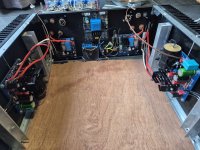 20241230_102417_s.jpg583.9 KB · Views: 183
20241230_102417_s.jpg583.9 KB · Views: 183 -
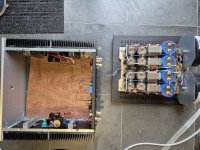 20241230_102358_s.jpg717.2 KB · Views: 176
20241230_102358_s.jpg717.2 KB · Views: 176 -
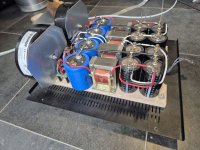 20241230_102156_s.jpg642.2 KB · Views: 183
20241230_102156_s.jpg642.2 KB · Views: 183 -
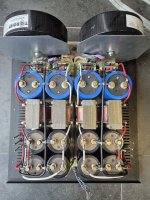 20241230_102146_s.jpg816.7 KB · Views: 189
20241230_102146_s.jpg816.7 KB · Views: 189 -
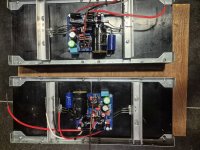 20241229_215350_s.jpg750.2 KB · Views: 178
20241229_215350_s.jpg750.2 KB · Views: 178 -
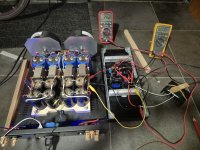 20241229_200702_s.jpg762.1 KB · Views: 172
20241229_200702_s.jpg762.1 KB · Views: 172 -
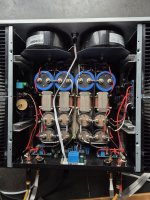 20241231_122135_s.jpg538.5 KB · Views: 181
20241231_122135_s.jpg538.5 KB · Views: 181
- Home
- Amplifiers
- Solid State
- Alpha Nirvana 39w 8ohm Class A Amp
